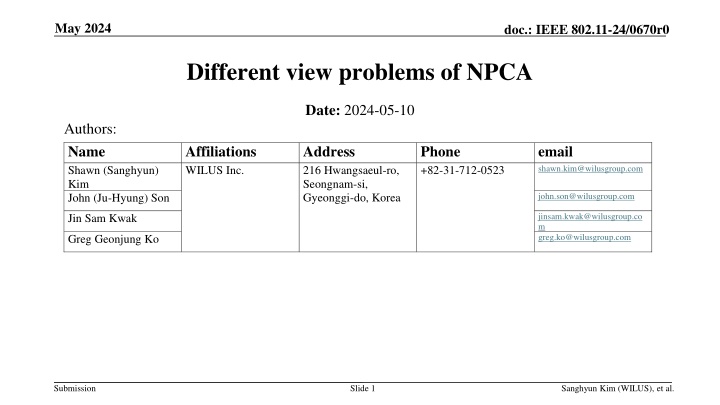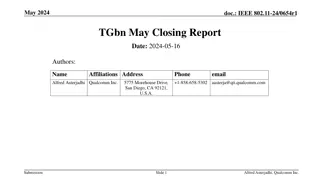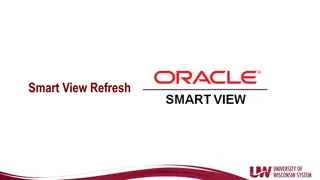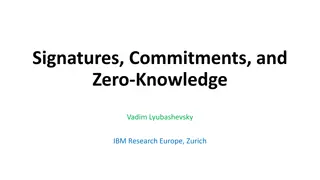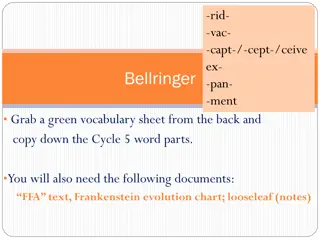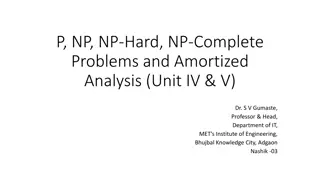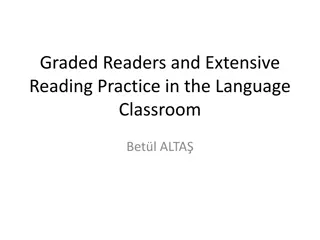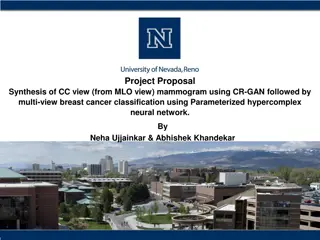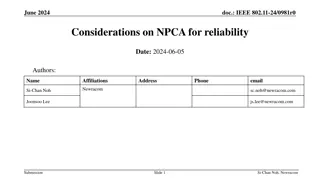Different view problems of NPCA
In this document dated May 2024, the authors from WILUS Inc. discuss the various issues related to Non-Primary Channel Access (NPCA) in the context of IEEE 802.11-24. The problems outlined include scenarios where the AP side is busy while the non-AP STA side is idle, and vice versa. Proposed solutions and ongoing technical discussions regarding NPCA are highlighted, emphasizing the importance of addressing these challenges in the realm of UHR technologies.
Uploaded on Mar 09, 2025 | 1 Views
Download Presentation

Please find below an Image/Link to download the presentation.
The content on the website is provided AS IS for your information and personal use only. It may not be sold, licensed, or shared on other websites without obtaining consent from the author.If you encounter any issues during the download, it is possible that the publisher has removed the file from their server.
You are allowed to download the files provided on this website for personal or commercial use, subject to the condition that they are used lawfully. All files are the property of their respective owners.
The content on the website is provided AS IS for your information and personal use only. It may not be sold, licensed, or shared on other websites without obtaining consent from the author.
E N D
Presentation Transcript
May 2024 doc.: IEEE 802.11-24/0670r0 Different view problems of NPCA Date: 2024-05-10 Authors: Name Shawn (Sanghyun) Kim John (Ju-Hyung) Son Affiliations WILUS Inc. Address 216 Hwangsaeul-ro, Seongnam-si, Gyeonggi-do, Korea Phone +82-31-712-0523 email shawn.kim@wilusgroup.com john.son@wilusgroup.com jinsam.kwak@wilusgroup.co m greg.ko@wilusgroup.com Jin Sam Kwak Greg Geonjung Ko Submission Slide 1 Sanghyun Kim (WILUS), et al.
May 2024 doc.: IEEE 802.11-24/0670r0 Introduction In TGbn, Non-Primary Channel Access (NPCA) mechanism has been proposed to enhance the utilization of secondary channels, and further details have been discussed # of auxiliary channel, NPCA TXOP limit, channel switching rules, etc. [1-18] ETSI regulation issues [19-23] While further discussions regarding ETSI regulation are imperative, it is important to persist with technical discussions on NPCA as a potential feature for UHR, especially considering the consensus on its overarching concept In this contribution, we discuss the different view problems of NPCA Submission Slide 2 Sanghyun Kim (WILUS), et al.
May 2024 doc.: IEEE 802.11-24/0670r0 Different view problems (Case 1/Case 2) Problems from the different views on the primary channel between AP and STA [1] Case 1: AP side is busy, but non-AP STA side is idle Non-AP STA Tx to the AP on P-channel, but the AP is not on the P-channel AP Tx on the nP-channel, but the non-AP STA is on the P-channel Case 2: AP side is idle, but non-AP STA side is busy Same problems occur as in Case 1 with the opposite Tx direction A solution for mitigating the problems was proposed in [2] (see APPENDIX for details) AP shares OBSS AP list that it detects to non-AP STAs A non-AP STA moves to nP-channel only when P-channel is occupied by an OBSS within the list AP can be sure that all non-AP STAs are on P-channel when it is on P-channel As a result, the solution ensures that Case 2 does not occur However, the solution does not ensure the prevention of Case 1 (further discussed in next slide) Submission Slide 3 Sanghyun Kim (WILUS), et al.
May 2024 doc.: IEEE 802.11-24/0670r0 Remaining problems (Case 1) Case 1: AP side is busy, but non-AP STA side is idle Applying similar approaches for the Case 1 may have limitations: Retrieving each OBSS AP list from each non-AP STA may incur overhead Still a non-AP STA cannot be sure that the AP is on P-channel Since the AP may move to nP-channel due to OBSS TXOP that is hidden from a certain non-AP STA Case 1 is a similar problem as which is already being experienced today APs do not respond to its non-AP STA when they see its P-channel busy Therefore, instead of solving the Case 1, we can define relevant rules for NPCA AP/STAs when Case 1 is occurred Submission Slide 4 Sanghyun Kim (WILUS), et al.
May 2024 doc.: IEEE 802.11-24/0670r0 AP s responding rule for Case 1 An AP on nP-channel receives an initial frame from a non-AP STA still on P-channel The AP could partially receive the frame on nP-channel if it is carried in non-HT duplicate PPDU The non-AP STA might be a legacy STA which doesn t support NPCA, or The non-AP STA might be a NPCA STA hidden from the OBSS occupying P-channel of the AP 802.11 baseline doesn t provide the rules to response to the frame partially received on nP-channel Therefore, initial control frame responding rule for an NPCA AP for Case 1 should be defined AP receives frame on nP-Channel Non-HT Non-HT S80 Non-HT Non-HT nP-Channel Non-HT Non-HT OBSS TXOP (AP-side) P80 Non-HT Non-HT P-Channel Tx by a P-channel STA Frame exchange sequence (AP s view) Submission Slide 5 Sanghyun Kim (WILUS), et al.
May 2024 doc.: IEEE 802.11-24/0670r0 nP-channel AP s ICF Responding Rule Possible options for nP-channel AP s ICF responding rule Option 1: nP-channel AP responds to an ICF sent from both P-channel/nP-channel STAs Option 2: nP-channel AP responds to an ICF sent from only nP-channel STA Basic assumption: nP-channel AP does not respond to legacy STAs *P-channel STA: An NPCA STA operating on primary channel *nP-channel STA: An NPCA STA operating on non-primary channel Submission Slide 6 Sanghyun Kim (WILUS), et al.
May 2024 doc.: IEEE 802.11-24/0670r0 Option 1 CTS Rx RTS Frame exchanges (TXOP of non-AP STA) CTS Rx RTS S80 Rule: nP-channel AP responds to an ICF sent from both P-channel/nP-channel STAs Pros P-channel STA can exchange frame with nP-channel AP even under Case 1 scenario Cons Enhancement on frame exchange sequence required on both AP and non-AP STA CTS Rx RTS CTS Rx RTS MSD.. OBSS TXOP P80 AP side Rx CTS RTS Frame exchanges (TXOP of non-AP STA) Rx CTS RTS S80 Rx CTS RTS Rx CTS RTS RTS RTS P80 RTS RTS Requirements P-channel STA Non-AP STA side (hidden from the OBSS) After sending ICF, P-channel STA needs to detect and decode ICR on nP-channel and switch to nP-channel operation nP-channel AP Needs to determine whether the received ICF is from a NPCA STA before transmitting ICR AP should not respond to frames from a legacy STA (AP is operating on S80 due to OBSS TXOP) 1. A non-AP STA transmits RTS frame using 160 MHz non-HT duplicate PPDU 2. AP operating on S80 receives the PPDU and respond with CTS frame on S80 3. The non-AP STA performs frame exchange on S80 after receiving the CTS frame AP Non-AP STA OBSS (Occupying P80) Submission Slide 7 Sanghyun Kim (WILUS), et al.
May 2024 doc.: IEEE 802.11-24/0670r0 Option 2 AP does not respond to RTS frame transmitted by STA1 (P-channel STA) Rx RTS (STA1) Rx RTS (STA2) CTS Rule: nP-channel AP responds to an ICF sent from only nP-channel STA Pros Simpler non-AP STA operation than Option 1 Cons Enhancement on frame exchange sequence required on AP S80 Rx RTS (STA1) Rx RTS (STA2) CTS Frame exchanges (TXOP of STA2) Rx RTS (STA1) Rx RTS (STA2) CTS Rx RTS (STA1) Rx RTS (STA2) CTS MSD.. Rx RTS (STA1) Rx RTS (STA1) OBSS TXOP P80 Rx RTS (STA1) Rx RTS (STA1) AP side (AP and STA2 are operating on S80 due to OBSS TXOP) 1. STA1 transmits RTS frame using 160 MHz non-HT duplicate PPDU 2. AP operating on S80 receives the PPDU and does not respond to the RTS frame sent from P-channel STA1 3. STA2 transmits RTS frame on S80 4. AP responds to the RTS frame sent from nP-channel STA2 5. STA2 performs frame exchange on S80 after receiving the CTS frame Requirements nP-channel AP Needs to determine whether the received ICF is from a nP-channel STA before transmitting ICR To help AP operation, NPCA non-AP STAs may indicate the current operating channel (P- or nP-) information when it transmit an ICF AP STA 1 STA 2 OBSS (Occupying P80) Submission Slide 8 Sanghyun Kim (WILUS), et al.
May 2024 doc.: IEEE 802.11-24/0670r0 AP s channel access after not responding an ICF In both options, nP-channel AP would not repose to an ICF (e.g., RTS) addressed to it when The ICF is from legacy STA (Option 1&2) or the ICF is from P-channel STA (Option 2) Then the AP continues channel access after not responding to the ICF The AP resets MediumSyncDelay timer after receiving the ICF Assumption: MSD timer (11be) is applied for the AP, and the timer can be reset when the AP receives an MPDU (as defined in 11be for the non-AP STA) Since the frame is addressed to the AP, it doesn t set its NAV while the other STAs set their NAVs The other STAs may reset their NAV after NAVTimeout period if the ICF is RTS During the NAVTimeout period (or whole NAV duration), AP gains an advantage in the contention on nP-channel AP can decrease backoff counter after this slot boundary The other STAs on nP-channel received the RTS frame have non-zero NAV until here NAVTimeout Rx RTS Rx RTS S80 Rx RTS Slot boundaries nP-Channel AIFS Rx RTS MSD Rx RTS OBSS TXOP (AP-side) Rx RTS P80 Rx RTS Rx RTS P-Channel Submission Slide 9 Sanghyun Kim (WILUS), et al.
May 2024 doc.: IEEE 802.11-24/0670r0 AP s channel access after not responding an ICF (cont.) NAVTimeout period is long enough for the AP to complete its exclusive channel access NAVTimeout: 2 aSIFSTime + CTS_Time + aRxPHYStartDelay + 2 aSlotTime CTS_Time is 44 us for 6 Mbps RTS frame and 28 us for 24 Mbps RTS frame aRxPHYStartDelay is at least 20 us The AP have more than 7 contention-free slot boundaries (for AC_VO(AIFSN=2)) during NAVTimeout Thus nP-channel AP s backoff procedure after not responding an ICF can be regarded as unnecessary overhead To reduce the overhead, it would be advantageous to allow nP-channel AP to access the channel after receiving an ICF (RTS) frame from a P-channel/Legacy STA i.e., AP transmits its own ICF to other nP-channel STA after SIFS/PIFS TXOP of AP - Option 1: AP can leverage ICF (RTS) from legacy STA Rx ICR Rx RTS Tx ICF Rx ICR Rx RTS Tx ICF 80 MHz S80 Frame exchanges Rx ICR Rx RTS Tx ICF - Option 2: AP can leverage ICF (RTS) from legacy STA and P-channel STA nP-Channel Rx ICR Rx RTS Tx ICF MSD Rx RTS OBSS TXOP (AP-side) Rx RTS P80 Rx RTS Rx RTS *Frame exchange sequence (AP s view) P-Channel Submission Slide 10 Sanghyun Kim (WILUS), et al.
May 2024 doc.: IEEE 802.11-24/0670r0 Summary Different view problems of NPCA have been discussed Case 1: AP side is busy, but non-AP STA side is idle Case 2: AP side is idle, but non-AP STA side is busy For Case 1, two ICF responding options of nP-channel AP have been discussed Also, channel access enhancements for nP-channel AP after not responding an ICF have been discussed Submission Slide 11 Sanghyun Kim (WILUS), et al.
May 2024 doc.: IEEE 802.11-24/0670r0 Straw Poll 1 Do you support to define in 11bn a mode of operation that enables a STA to access the secondary channel while the primary channel is known to be busy due to OBSS traffic or other TBD conditions? Submission Slide 12 Sanghyun Kim (WILUS), et al.
May 2024 doc.: IEEE 802.11-24/0670r0 Straw Poll 2 Do you agree to define mechanisms to mitigate problems caused by the different views on the primary channel between AP and non-AP STA for the following two cases? Case 1: An AP determines the primary channel is idle while a non-AP STA determines the primary channel is busy Case 2: A non-AP STA determines the primary channel is idle while an AP determines the primary channel is busy Submission Slide 13 Sanghyun Kim (WILUS), et al.
May 2024 doc.: IEEE 802.11-24/0670r0 References [1] 11-23/961 [2] 11-23/2005 Non-primary channel access [3] 11-23/34 Non-primary channel utilization [4] 11-23/631 Secondary channel usage and secondary 20MHz channel backoff [5] 11-23/797 Non-primary channel access [7] 11-23/962 UHR secondary channel access evaluation [8] 11-23/1112 Thoughts on secondary channel access [9] 11-23/1288 Non-primary channel utilization follow-up [10] 11-23/1414 Secondary channel usage follow up [11] 11-23/1444 Non-primary channel access evaluation follow-up [12] 11-23/1911 Secondary channel access and frame transmission [13] 11-23/1913 Secondary channel access operation [14] 11-23/1935 Secondary channel usage follow up [15] 11-23/1951 Concurrent CCA for non-primary channel access [16] 11-23/2039 Secondary channel usage follow up [17] 11-24/70 Some details about non-primary channel access [18] 11-24/538 SP-based non-primary channel access [19] 11-23/1365 Discussions on non-primary channel access [20] 11-23/2023 Further discussion on non-primary channel access [21] 11-24/486 Some considerations on non-primary channel access [22] 11-24/573 Channel bonding rules in EN 301 893 & EN 303 687 [23] 11-24/458 Considerations on Non-Primary Channel Access UHR secondary channel access Minyoung Park Minyoung Park Sindhu Verma Liwen Chu Yongho Seok Dibakar Das Insun Jang Sindhu Verma Liwen Chu Dibakar Das Dongju Cha Dongju Cha Liwen Chu Leonardo Lanante Liwen Chu Yunbo Li Yue Zhao Sanghyun Kim Sindhu Verma Ming Gan Guido R. Hiertz Salvatore Talarico Submission Slide 14 Sanghyun Kim (WILUS), et al.
May 2024 doc.: IEEE 802.11-24/0670r0 APPENDIX (11-23/2005r1) Proposal to address different views of medium busy/idle a) In a BSS, each AP/STA build a list of OBSS APs (for simplicity) that they can hear on the primary channel (see examples below) - AP1{AP2} - STA1{AP3} - STA2{AP2} b) AP announces to its associated STAs the list of OBSS APs that it received (e.g., in a beacon frame) AP1 {AP2} c) Each STA compares the OBSS AP list that it received from the AP with the list of OBSS APs each STA can hear and indicate this to the AP - STA1{none} - STA2{AP2} d) When a STA receives a frame from an OBSS AP that was included in the OBSS AP list received from the AP, the STA moves to P2 and may initiate TXOP to the AP; otherwise stays on P1. - STA1: doesn t move to P2 when it receives a frame from AP3 - STA2: moves to P2 when it receives a frame from AP2; may initiate TXOP to AP1 e) When the AP receives a frame from an OBSS AP that it included in the OBSS AP list and the OBSS AP was indicated by a STA in c), it moves to P2 and may initiate TXOP to the STA. - AP1: moves to P2 when it receives a frame from AP2; may initiate TXOP to STA2 Submission Slide 15 Sanghyun Kim (WILUS), et al.
